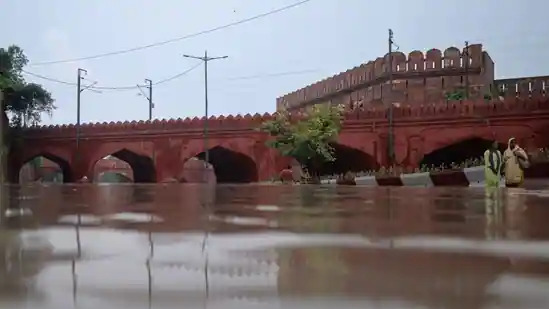Numerous efforts underway to tackle urban floods by Union Government: MoS, Jal Shakti
Author: BI Bureau

New Delhi: The Government on Monday said that it has taken several initiatives to contain urban floods. In Rajya Sabha Minister of State for Jal Shakti, Bishweswar Tudu listed various programs undertaken by the government towards tackling floods in urban areas.
Increased incidence of high intensity rainfall in short duration is mainly responsible for urban floods which is further compounded by unplanned growth, encroachment of natural water bodies, poor drainage system, etc. Management of urban flooding falls under purview of the State Governments and the Urban Local Bodies / Urban Development Authorities who are responsible for maintaining the drainage and sewerage system.
Several initiatives have been taken by Union Government to encourage groundwater recharge and other nature-based solutions to tackle urban flooding in flood-prone areas. Master Plan for Artificial Recharge to Groundwater - 2020 has been prepared by the Central Ground Water Board (CGWB) in collaboration with States/UTs envisaging construction of about 1.42 crore rain water harvesting and artificial recharge structures in the country to harness 185 Billion Cubic Meter (BCM) of water. The Master Plan has been shared with States/UTs for suitable interventions.
Government of India is implementing Jal Shakti Abhiyan (JSA) in the country in which special emphasis is being given for rainwater harvesting/groundwater recharge. First JSA was launched in 2019 in water stressed blocks of 256 districts. JSA was continued during the years 2021 and 2022 also (across entire country both rural and urban areas) with the primary aim to effectively harvest the monsoon rainfall through creation of artificial recharge structures, watershed management, recharge and reuse structures, intensive afforestation and awareness generation etc. JSA for the year 2023 has been launched by Hon'ble President of India on 4th March 2023 with the theme “Source Sustainability for Drinking Water”.
The Minister also pointed out that Amrit Sarovar Mission has been launched with an aim of developing and rejuvenating 75 water bodies in each district of the country as a part of celebration of Azadi ka Amrit Mahotsav for rainwater harvesting/recharge. The Central Government is also implementing Atal Bhujal Yojana involving the local communities at village levels with an outlay of Rs. 6,000 crore, in collaboration with States, in certain water stressed areas of Gujarat, Haryana, Karnataka, Madhya Pradesh, Maharashtra, Rajasthan and Uttar Pradesh.
Under Atal Bhujal Yojana, the focus is on demand side management of ground water and accordingly water saving interventions such as use of micro irrigation (drip/sprinkler system), shifting of cropping pattern from high water intensive crops to low water intensive crops, mulching etc. are being encouraged and incentivised.
Tudu informed that under the Atal Mission for Rejuvenation and Urban Transformation (AMRUT) 2.0 Scheme, provisions have been made for harvesting the rainwater through storm water drains into water body (which is not receiving sewage/effluent) & creation/ strengthening of storm water drains around water body.
Ministry of Housing & Urban Affairs (MoHUA) has formulated Model Building Bye Laws (MBBL), 2016 for the States/UTs. As per MBBL, all buildings having a plot size of 100 sq.m. or, more shall mandatorily include the complete proposal of rainwater harvesting. 35 States/ UTs have adopted the features of the Bye Laws.
Apart from works carried out for artificial recharge of ground water by the respective State/UT Governments, CGWB has implemented artificial recharge work in three Aspirational Districts, Osmanabad (Maharashtra), YSR Kadapa (Andhra Pradesh) and Jangaon (Telangana). In these Districts, 176 structures have been constructed to harvest the runoff water in stream to store at suitable locations for augmenting recharge to the ground water.
CGWB has also implemented Bridge cum Bandhara (BCB) for ground water recharge in the districts of Wardha and Amravati of Maharashtra State at five locations. Under the project ‘Groundwater augmentation through artificial recharge in identified water stressed areas of Rajasthan’ in the Districts of Jodhpur, Jaisalmer & Sikar recharge structures comprising of 2 Earth Dams, 55 check dams, 24 anicuts and 1 recharge shaft have been constructed by CGWB.
The National Water Policy (2012) formulated by the Jal Shakti Ministry inter alia advocates that the conservation of rivers, river corridors, water bodies and infrastructure should be undertaken in a scientifically planned manner through community participation. The storage capacities of water bodies and water courses and/or associated wetlands, the flood plains, ecological buffer and areas required for specific aesthetic recreational and/or social needs may be managed to the extent possible in an integrated manner to balance the flooding, environment and social issues as per prevalent laws through planned development of urban areas, in particular, a PIB release said, quoting the Minister.
Urban settlements, encroachments and any developmental activities in the protected upstream areas of reservoirs / water bodies, key aquifer recharge areas that pose a potential threat of contamination, pollution, reduced recharge and those endanger wild and human life should be strictly regulated.
MoHUA has issued Standard Operating Procedures (SoPs) on Urban Flooding in 2017 and published manual on Storm Water Drainage Systems, 2019 to assist the States/ Union Territories (UTs), Urban Local Bodies (ULBs) and other stakeholders on planning, design, operation and maintenance of storm water drainage systems and to assist all States/ UTs to raise the level of preparedness in the event of urban flooding, and for emergency operations, including rescue and restoration of services. /BI/



